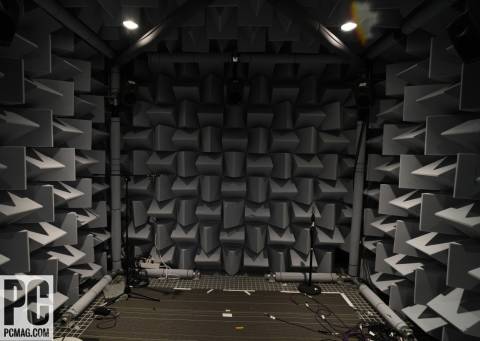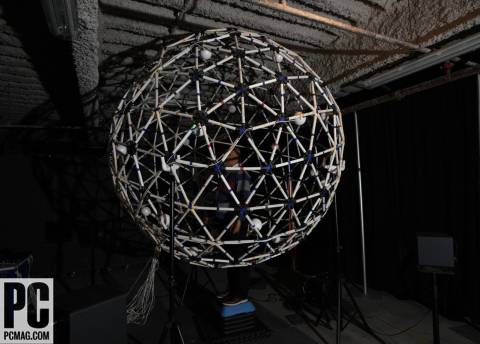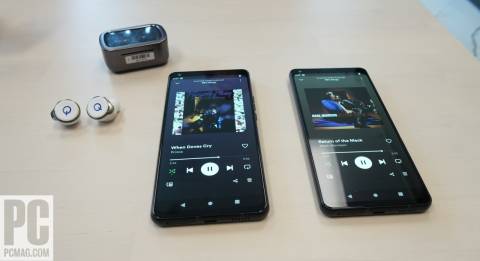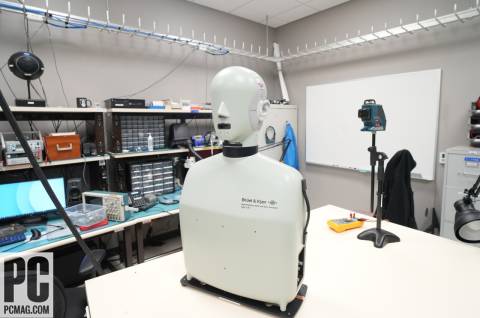Listening to music on your phone is more than a matter of streaming something from Spotify and putting on headphones—a lot of processing steps take place between your favorite media service, your device, and your ears. Qualcomm is one of the many companies that manage those steps, particularly when it comes to Android phones that use its Snapdragon processors.

I recently visited Qualcomm's headquarters in San Diego and toured its audio lab, where it develops and refines how Snapdragon-powered devices handle music and other audio content. While there, I also tried some of the newest features that Qualcomm's audio platform, Snapdragon Sound, will support on future phones.

Qualcomm's Sound Spaces

Qualcomm’s audio testing lab consists of several sections across multiple floors, all with different purposes. The purest, most precise sound measurements take place in three acoustic anechoic chambers built in the lab.
Qualcomm's acoustic anechoic chamber is designed to enable complete silenceAcoustic anechoic chambers are more than soundproof rooms; they’re effectively anti-sound rooms. They’re designed to enable complete silence by not only blocking all outside noise entirely but also by preventing any sort of sound reflection within the space itself. The largest of the lab’s chambers, a nine-ton box that multiple people can stand in, is mounted on vibration-dampening isolators and uses huge wedge-shaped foam sections installed on most surfaces to absorb most sound frequencies down to about 160Hz.

The lab employs two additional, smaller chambers of similar design, each just big enough to accommodate a Head and Torso Simulator (HATS), or a testing dummy about the size of a human upper body with microphones designed to precisely simulate human hearing. Testing is performed in all three chambers using a HATS, reference microphones to measure speaker output, and reference speakers to measure microphone input.

To test and further develop spatial audio technology, the lab has to be able to record and analyze sound coming from multiple directions. To do this, Qualcomm built a testing sphere. The geodesic ball is large enough for a person to fit inside and is equipped with 25 speakers pointing at the center from multiple directions. An engineer (or a HATS) can be placed in the middle of the sphere to receive the multidirectional audio signals and gauge performance.
This spatial audio sphere is large enough for someone to fit inside and is equipped with 25 speakers pointing at the center from different directionsOther spaces are set up around the lab for more real-world-style testing, including three sound-dampened (but not anechoic) rooms for analyzing how voice assistant devices like smart speakers process voices. There are also spaces arranged like offices and living rooms, including the one where Qualcomm demonstrated some of Snapdragon Sound’s advanced features.
Snapdragon Sound's New Tricks
Snapdragon Sound is Qualcomm’s audio platform, a collection of unifying technologies in phones, headphones, and other audio-related devices. Snapdragon Sound enables functions like lossless audio over Bluetooth, head-tracking spatial audio, and Auracast broadcast audio between multiple sets of transmitters. Qualcomm’s director of Snapdragon Sound, Mike Canevaro, demonstrated these three features for me.
Lossless Audio Over Bluetooth
Lossless audio over Bluetooth is just what it sounds like: The ability to listen to lossless audio files over Bluetooth. It isn't easy to accomplish due to Bluetooth’s limited data bandwidth, which is why virtually all Bluetooth devices use lossy audio codecs instead. Qualcomm’s AptX Lossless codec is one of the few exceptions to that rule: It is able to scale audio signals up to lossless quality when wireless conditions can manage it (for example, when there are no other devices nearby), and scale the signal down to lossy quality in crowded wireless environments. AptX Lossless is an evolution of AptX Adaptive, an earlier AptX codec that also can adjust the quality of the signal on the fly.
This Head and Torso Simulator (HATS) is a testing dummy about the size of a human upper body with microphones designed to precisely simulate human hearing“Today, we continue to be the only company anywhere in the world that can actually provide a lossless solution over Bluetooth,” Canevaro said. “By utilizing our AptX Adaptive encoding, we’re actually able to scale up to 1.2 megabits per second, so we can actually stream lossless over the link. Today, we’re doing [24-bit/96kHz] high-res audio, 16-bit/44.1 CD lossless, and 16-bit/48 lossless.”
I listened to some AptX Lossless audio over Bluetooth using Qualcomm development hardware. Audio clarity and detail can be as much a question of the gear as the signal being sent to it, and even high-quality lossy audio can sound excellent with the right earphones. Still, the test tracks I listened to on Qualcomm’s earphones sounded incredibly detailed and subtle over Bluetooth—comparable, even, with high-end wired earphones. My first impression is that AptX Lossless has a noticeable signal quality edge over both AAC and LDAC. Of course, like all codecs, AptX Lossless requires both your phone and headphones to support it.
Head-Tracking Spatial Audio
I also tried Snapdragon Sound’s head-tracking spatial audio feature. The platform supports sound sources from multiple directions, not only by mixing audio to simulate directional imaging but by using motion sensors in headphones to adjust those sources on the fly based on how you move your head.
The demo was a simple promotional video of the technology with spatial audio information encoded in it. The narrator in the video sounded like she was speaking directly in front of me, and as I turned my head left and right her voice panned between my ears to stay anchored relative to my position. It was an effective demo for horizontal positioning, though the head tracking didn’t fare so well vertically; tilting my head up and down didn’t adjust the sound quite as realistically as when I rotated it left and right.
We’ve seen head-tracking spatial audio before in the Apple AirPods Max and AirPods Pro, and in certain gaming headsets like the Audeze Mobius, while this kind of audio processing is common in virtual reality headsets. Snapdragon Sound is a promising way to bring this experience to Android devices over Bluetooth, though it will require headphones with built-in motion sensors to work. And, like other device-based head-tracking spatial audio, Snapdragon Sound’s implementation works with a wide variety of standardized spatial audio content, like Dolby Atmos.
Auracast on Snapdragon SoundAuracast: Multi-Point Public Audio
Finally, Auracast is one of the newest features introduced by the Bluetooth Special Interest Group (SIG), the standards organization that oversees Bluetooth. It lets Bluetooth headphones wirelessly connect to and switch between multiple publicly broadcasting devices. This feature can let museum visitors access virtual guides for different exhibits, or allow workout enthusiasts to tune into one of any of the TVs around a gym just by tapping their earphones. Auracast differs from headphones that simply support two simultaneous connections because it doesn’t pair to just one (or two) devices; instead, it quickly switches between a potentially unlimited number of publicly broadcasting devices. Auracast is still in its early phases, but Snapdragon Sound will support it.
I tried the Snapdragon Sound implementation of Auracast at Qualcomm’s test lab. Two phones were set in front of me and each began broadcasting via Auracast. I put in my test earphones and could jump back and forth between the two phones by double-tapping one of the earpieces. It worked almost flawlessly, though there was a half-second hiccup during each switch where I could only hear sound through the left earphone before both fully kicked in. Still, this was highly functional for a tech demo.
The Future of Listening
While all of these features fall under the Snapdragon Sound label, each one has its own requirements between both Snapdragon-powered phones and headphones to work. Whether you want lossless Bluetooth audio, motion-based spatial audio, or Auracast compatibility, each individual feature's implementation on a given pair of headphones will depend on the manufacturer.
Qualcomm makes the chipsets and unifying software elements that enable these features, but you won't actually get to experience them through your own ears until consumer devices start to implement them. It's clear that Qualcomm is doing a lot of work to make this possible, and we'll likely see new products that take advantage of its work in the near future.
For more on the technology that shapes what you listen to, check out our guides to Bluetooth codecs, equalizers, and lossless audio.
